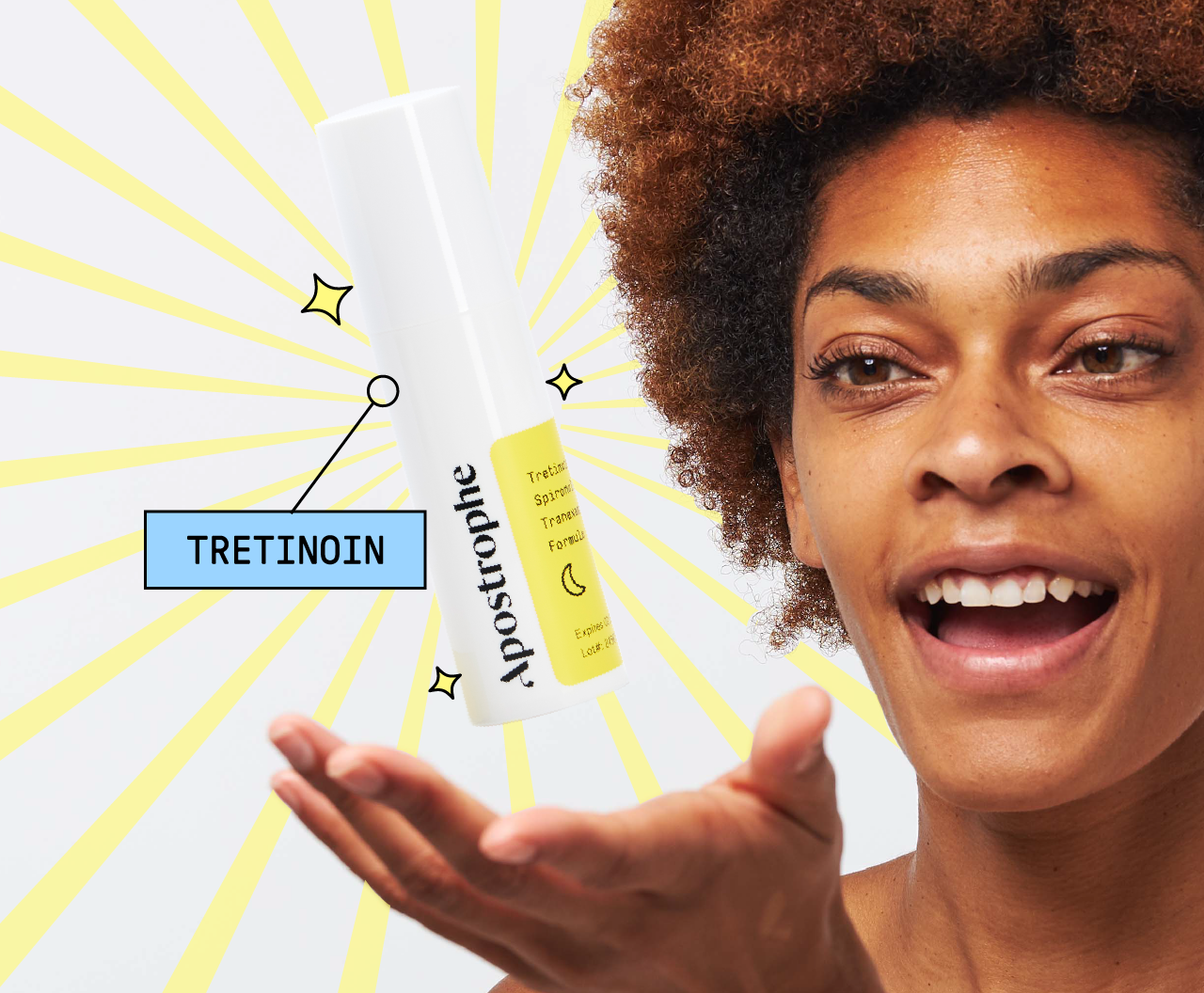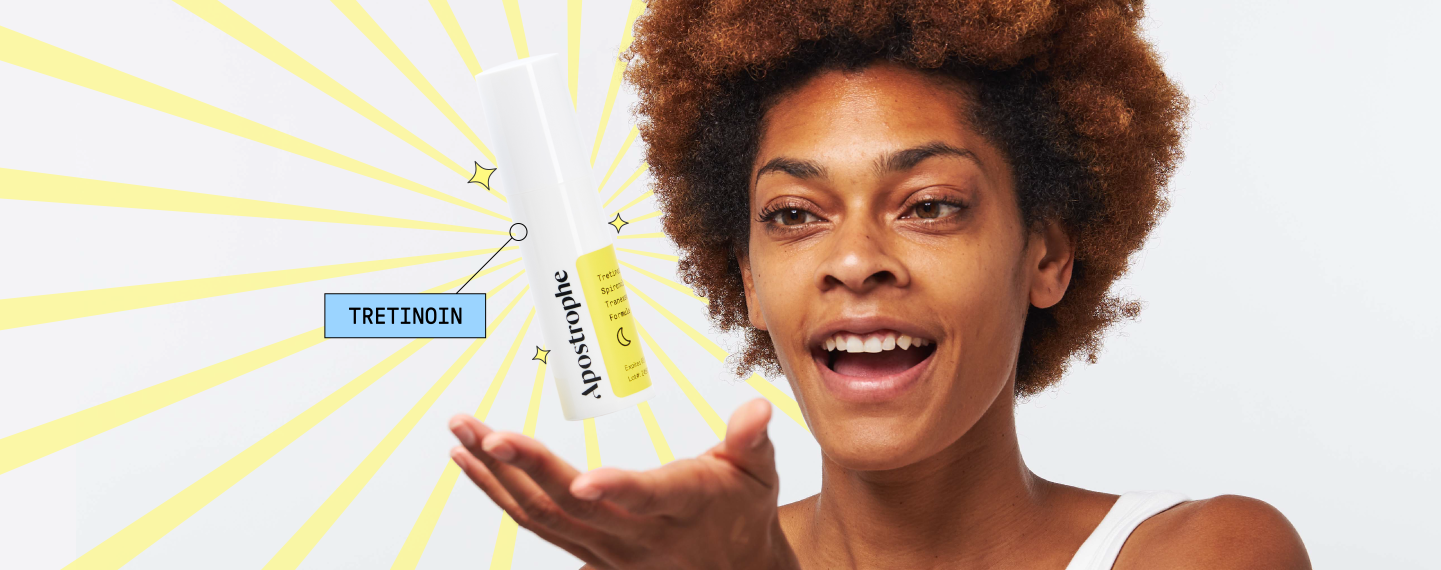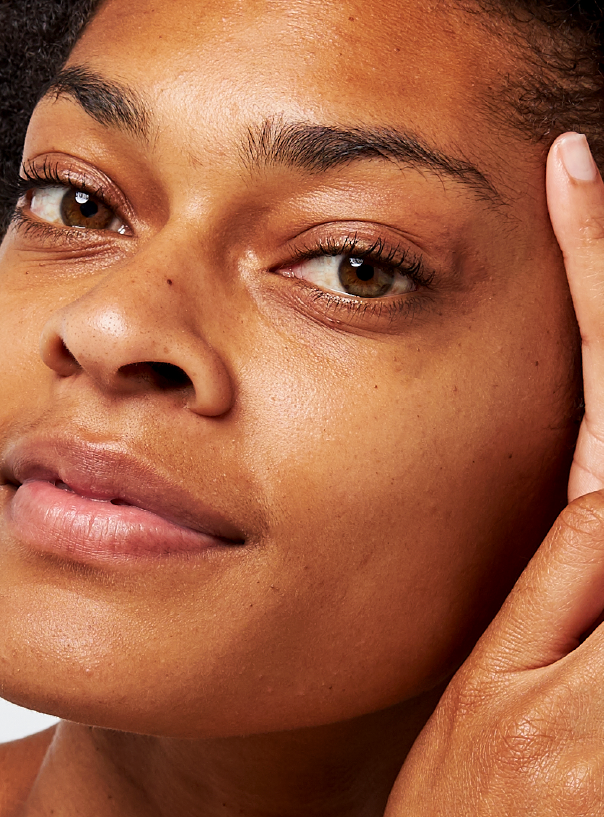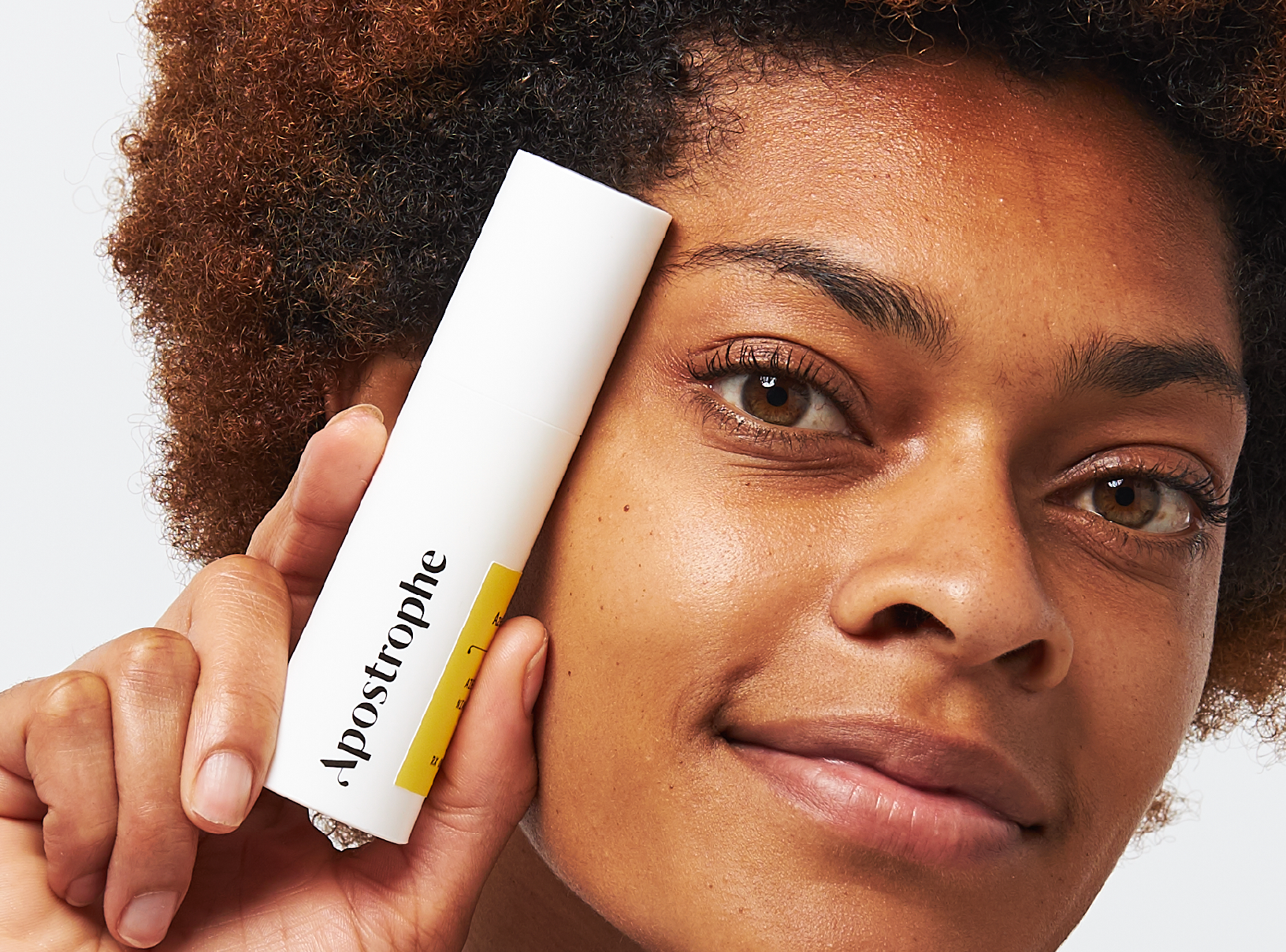Education
How to Use Tretinoin for Wrinkles and Skin Aging


SHARE
Education
How to Use Tretinoin for Wrinkles and Skin Aging
Medically reviewed by Aimee Paik, MD
Written by Apostrophe Team
Last updated 4/5/2024
Have you started to notice wrinkles developing on your face? From crow’s feet to frown lines and forehead wrinkles, facial wrinkles can develop in a variety of locations.
Most people begin to spot wrinkles during their mid to late 20s, with wrinkles often becoming more obvious in their 30s and 40s.
Although everyone is different, it’s normal to notice some level of wrinkle development as you get older.
One of the most effective anti-aging and wrinkle prevention treatments is tretinoin -- a topical medication that is applied directly to your skin.
Below, we’ve explained how tretinoin works, as well as how you can use it as a treatment for wrinkles and skin aging.
How Wrinkles and Other Signs of Aging Develop
Before we get into the specifics of tretinoin, let’s go over the basics of how skin aging actually develops in the first place.
Contrary to popular belief, wrinkles don’t develop overnight.
Instead, most people only notice wrinkles after they begin to become deeper, more pronounced and obvious -- a process that often takes several years.
During your 20s and 30s, your skin starts to become thinner, dryer and less elastic, which can cause wrinkles to develop.
Gravity may also begin to take its toll on your face, causing the skin around your cheeks, eyes and jawline to start to sag.
Other common signs of aging, such as age spots and discoloration often develop at the same time.
These effects are the result of intrinsic changes that occur in your skin as you age. As you grow older, your skin’s collagen production drops.
Your skin also produces new cells at a slower pace through the skin cell turnover process, meaning it’s less able to repair and rejuvenate itself.
Part of this process is unavoidable -- a result of genetic factors. However, some environmental factors can speed up the process and make the effects of aging more visible.
One of the biggest factors in aging is your exposure to the sun, which contributes to something called photoaging.
When UV radiation from the sun penetrates into your skin, it damages cells and causes your skin to deteriorate at a faster pace.
This photodamaged skin may take on a rough texture, with deep wrinkles and other clear signs of aging.
According to the Skin Cancer Foundation, UV-related photoaging is responsible for as much as 90 percent of the change that occurs in your skin as you get older. Smoking also rapidly accelerates skin aging.
How Tretinoin Treats Wrinkles and Signs of Aging
So, how does tretinoin fit into this process? Tretinoin belongs to a class of medications referred to as retinoids.
It works by speeding up your skin’s cellular turnover process, allowing your skin to create new cells and repair itself at a faster rate.
This has major consequences for your skin, as it allows fresh skin cells formed deep inside your epidermis to replace old ones in less time than normal.
You can think of tretinoin as acting similar to a fast-forward button for your skin’s creation of new cells. Instead of sticking around, the outer layer of your skin that’s exposed to sunlight, wind and pollution is cycled off more efficiently, giving your skin a fresher, less weathered appearance.
Tretinoin also stimulates the production of new collagen when used for at least six months.
As a result of its effects on your skin’s cellular turnover speed, tretinoin reduces the appearance of wrinkles, evens out your skin’s pigmentation and also treats skin issues such as acne.
The end result is smoother, younger looking skin that’s much less affected by fine lines, wrinkles or other common signs of aging.
Tretinoin for Wrinkles: The Research
Unlike other anti-aging treatments, many of which you can purchase over the counter, tretinoin is only available as a prescription medication.
Compared to over-the-counter anti-aging products, tretinoin is significantly more effective, with numerous scientific studies showing that it can treat wrinkles, age spots and other age-related skin issues.
We’ve discussed some of the most notable research into tretinoin as a treatment for skin aging below.
In one study published in the British Journal of Dermatology, researchers found that treatment with tretinoin produced “significant improvements” in fine wrinkling near the eyes, crease lines around the mouth and cheeks, skin discoloration and other signs of skin aging.
Another study published in JAMA: The Journal of the American Medical Association found that tretinoin produced noticeable improvements in skin aging over the course of 16 weeks.
A more recent review published in the journal Clinical Interventions in Aging looked at a variety of studies of tretinoin and other topical retinoids, noting that several studies showed significant improvements among people who used topical tretinoin for anti-aging.
The review concluded that retinoids, the class of medications that tretinoin belongs to, are the most promising medications available for treating aging.
Put simply, there’s a metaphorical mountain of scientific data to back up the fact that tretinoin works well as a treatment for skin aging.
You can view more research on tretinoin’s effectiveness as an anti-aging treatment and acne medication in our full guide to how tretinoin works.
How to Use Tretinoin Cream for Wrinkles and Anti-Aging
Beyond its effectiveness, one of the biggest advantages of tretinoin is that it’s extremely easy to use.
Tretinoin is sold as a topical cream, gel or solution. To use it, all you need to do is apply a small amount of the cream to your face, typically in the evening.
Below, we’ve covered how to use tretinoin cream in six simple steps:
Start By Washing Your Face
Before applying tretinoin, wash your face and hands using warm water. If required, you can also use a small amount of mild, non-irritating soap to clean your skin.
When you’re washing your face, avoid using harsh facial cleansers, acne treatments or anything else that could cause skin irritation, such as skin care products that contain benzoyl peroxide or salicylic acid.
Gently Blot Your Face Dry
Carefully wash away any soap. To dry your face, carefully blot it using a clean, soft towel. Avoid rubbing your face with the towel, as this can irritate your skin. Make sure your skin is completely dry to avoid irritation from tretinoin.
Apply a Small Amount of Tretinoin
Tretinoin is a powerful medication, meaning you don’t need to use very much to manage aging and acne.
Squeeze a small amount of tretinoin (roughly the size of a pea) onto your finger and gently apply the medication to your forehead, cheeks, chin and other areas of your face.
Make sure to apply tretinoin evenly to affected areas of your skin. A pea-sized amount of gel or cream should be enough to treat your whole face. If you use a product that contains tretinoin and other active ingredients, such as our Anti-Aging Cream, follow the instructions provided with the product to make sure that you use the correct amount.
Avoid Your Eyes, Nostrils and Other Sensitive Areas
Avoid applying tretinoin directly to your lips, nostrils or areas close to your lips. When applying tretinoin under your eyes, spread it away from your eyes. Use a margin of safety so that tretinoin is never too close to your eyelid margin.
After applying tretinoin, you should apply a moisturizer to prevent your skin from becoming dry -- a common side effect of tretinoin and other topical retinoids. You can even apply moisturizer before your anti-aging cream if your skin is sensitive.
How to Get the Most Out of Using Tretinoin for Wrinkles
While tretinoin is effective on its own, making a few simple changes to your skin care habits and lifestyle can improve its effects. Try to:
Use tretinoin consistently, even if its effects aren’t obvious at first. It takes several months for the effects of tretinoin to become visible, meaning you��’ll need to be patient in the first few months. Make sure to use tretinoin consistently -- over the long term, you’ll start to notice positive changes in your skin’s appearance and texture.
Protect yourself from sunlight. A common side effect of tretinoin is an increase in your skin’s sensitivity to sun exposure. Try to avoid unnecessary or prolonged exposure while you’re using tretinoin, especially during peak sunlight hours. When you spend time outdoors, use an SPF 30+ sunscreen and use a wide-brimmed hatto shield your skin from UV-related damage.
Understand tretinoin’s side effects. Tretinoin can cause side effects, especially during the first few weeks of use. Common issues include dry skin, a stinging sensation and, in some cases, an increase in acne breakouts.These side effects eventually go away, but they can be annoying to deal with when they first occur. We’ve provided more information about these side effects and the steps that you can take to manage them further down the page.
Choosing the Right Strength of Tretinoin Cream
Tretinoin is available as a cream, gel and as an active ingredient in many prescription skin care products.
Like many other skin care medications, it’s available in several concentrations to suit the needs of different users.
Skin care medications containing tretinoin can range from .01% tretinoin to a maximum strength of .1% tretinoin.
Most anti-aging studies show that the best results usually come from low to moderate strength tretinoin creams, such as those that contain .025-0.05tretinoin% .
For example, a study published in the journal Archives of Dermatology compared the effects of a .05% tretinoin cream with a less powerful .01% tretinoin cream.
After 24 weeks, 79 percent of the people that used the .05% tretinoin cream showed reductions in factors such as fine wrinkling, rough skin and hyperpigmentation (a form of discoloration that causes dark spots), compared to fewer people who used the lower-strength tretinoin cream.
With this said, it’s important to note that lower-strength tretinoin creams are generally less likely to produce side effects.
If you’re prescribed tretinoin, your healthcare provider will work with you to choose a medication that offers the best balance between optimal results and side effects.
Dealing With Tretinoin Side Effects
Tretinoin is a safe and effective medication that’s used by people of all ages and backgrounds to treat acne and skin aging.
As a topical medication, it doesn’t pass through the liver or have systemic effects in the way that other skin care medications, such as isotretinoin (previously sold as Accutane®) do.
However, like all medications, tretinoin does have several potential side effects that may occur if it’s used as an anti-aging treatment.
Common side effects of tretinoin include:
A warm or stinging sensation that affects the skin
Dry, painful, flaky or burning skin in treated areas
Red, scaling skin and noticeable skin irritation
A temporary increase in acne breakouts
Changes in your skin tone (lightening or darkening)
In rare cases, tretinoin can cause more serious side effects, such as blisters.
Overall, side effects from tretinoin tend to be mild and temporary. For most people, tretinoin is unlikely to cause anything other than light, temporary skin dryness and irritation.
When Should You Expect Results From Tretinoin?
While the anti-aging and wrinkle reduction benefits of tretinoin are real, they typically don’t occur overnight.
Like other medications, tretinoin needs time to affect your skin. On average, it takes eight to 24 weeks of treatment for tretinoin to produce noticeable improvements in wrinkles and other signs of aging.
One short study published in the Journal of Cosmetic Dermatology, which used a .025 percent tretinoin cream, found a “statistically significant improvement” after just 84 days.
Other research has found that the benefits from tretinoin become clearly visible after about six months of use.
As we’ve covered in our guide to how long tretinoin takes to work, you should generally expect to see results from tretinoin after three months, with more significant results visible near the 12 month point.
In the meantime, it’s important to be consistent and use tretinoin regularly, even if you don’t see any day-to-day changes in your skin.
The Bottom Line on Tretinoin for Wrinkles and Skin Aging
Tretinoin is one of the most effective medications available for reducing wrinkles and improving your skin texture.
Used in combination with other skin care products, tretinoin can give your skin a more youthful appearance and reverse many aspects of the skin aging process.
Sources
Skin Care and Aging. (2017, October 1). Retrieved from https://www.nia.nih.gov/health/skin-care-and-aging
Ganceviciene, R., Laikou, A.I., Theodoridis, A., Makrantonaki, E. & Zouboulis, C.C. (2012, July 1). Skin anti-aging strategies. Dermato Endocrinology. 4 (3), 308–319. Retrieved from https://www.ncbi.nlm.nih.gov/pmc/articles/PMC3583892/
Photoaging: What You Need to Know About the Other Kind of Aging. (2019, January 10). Retrieved from https://www.skincancer.org/blog/photoaging-what-you-need-to-know/
Do retinoids really reduce wrinkles? (2019, October 22). Retrieved from https://www.health.harvard.edu/staying-healthy/do-retinoids-really-reduce-wrinkles
Lever, L., Kumar, P. & Marks, R. (1990, January). Topical retinoic acid for treatment of solar damage. British Journal of Dermatology. 122 (1), 91-8. Retrieved from https://pubmed.ncbi.nlm.nih.gov/2404514/
Weiss, J.S., et al. (1988, January 22-29). Topical tretinoin improves photoaged skin. A double-blind vehicle-controlled study. JAMA. 259 (4), 527-32. Retrieved from https://pubmed.ncbi.nlm.nih.gov/3336176/
Mukerjee, S., et al. (2006, December). Retinoids in the treatment of skin aging: an overview of clinical efficacy and safety. Clinical Interventions in Aging. 1 (4), 327–348. Retrieved from https://www.ncbi.nlm.nih.gov/pmc/articles/PMC2699641/
Tretinoin Topical. (2019, March 15). Retrieved from https://medlineplus.gov/druginfo/meds/a682437.html
Weinstein, G.D., et al. (1991, May). Topical tretinoin for treatment of photodamaged skin. A multicenter study. Archives of Dermatology. 127 (5), 659-65. Retrieved from https://pubmed.ncbi.nlm.nih.gov/2024983/
Bouloc, A., Vergnanini, A.L. & Issa, M.C. (2015, January 21). A double-blind randomized study comparing the association of Retinol and LR2412 with tretinoin 0.025% in photoaged skin. Journal of Cosmetic Dermatology. 14 (1), 40-46. Retrieved from https://onlinelibrary.wiley.com/doi/full/10.1111/jocd.12131
Leyden, J.J., Grove, G.L., Grove, M.J., Thorne, E.G. & Lufrano, L. (1989, September). Treatment of photodamaged facial skin with topical tretinoin. Journal of the American Academy of Dermatology. 21 (3 Pt 2), 638-44. Retrieved from https://pubmed.ncbi.nlm.nih.gov/2674225/
Shop this post

Tretinoin
Like what you just read? Sign up for our email list to get the scoop on skincare science delivered straight to your inbox.

Education
What is milia?
What is milia? Today, we’re jumping into one type of bump that you may have heard about most commonly in infants — milia.
Read More
Education
Best moisturizer for acne-prone skin
If you have combination acne-prone skin, figuring out which moisturizer is best for your skin might be tough. In this guide, we break down the best moisturizer for combination, acne-prone skin.
Read More
Education
How to build a face care routine
As you get into skincare, it might seem overwhelming, especially trying to figure out the order you're supposed to apply products in. Below, we detail how to build a face care routine for your skin!
Read More
